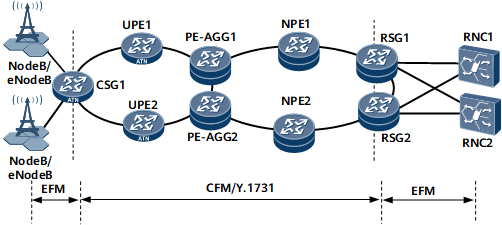Ethernet OAM Applications on an IPRAN
A mobile backhaul network shown in Figure 1 consists of a transport network between a cell site gateway (CSG) and remote service gateways (RSGs) and a wireless network between NodeBs/eNodeBs and the CSG. Carriers operate the transport and wireless networks separately. Therefore, traffic transmitted on the transport network of one carrier is invisible to devices on the wireless network of another carrier.
EFM monitors Layer 2 links between a NodeB/eNodeB and CSG1.
EFM is used to monitor the connectivity of links between a NodeB/eNodeB and CSG1 or between RNCs and RSGs.
EFM detects errored codes, frames, and frame seconds on links between a NodeB/eNodeB and CSG1 and between RNCs and RSGs. If the number of errored codes, frames, or frame seconds exceeds a configured threshold, an alarm is sent to the NMS. A network administrator is notified of link quality deterioration and can assess the risk of adverse impact on voice traffic.
Loopback is used to monitor the quality of voice links between a NodeB/eNodeB and CSG1 or between RNCs and RSGs.
CFM is used to locate faulty links over which E2E services are transmitted.
CFM periodically monitors links between cell site gateway (CSG) 1 and remote site gateways (RSGs). If CFM detects a fault, it sends an alarm to the NMS. A network administrator analyzes alarm information and takes measures to rectify the fault.
Loopback and linktrace are enabled on links between CSG1 and the RSGs to help link fault diagnosis.
Y.1731 is used together with CFM to monitor link performance and voice and data traffic quality.
